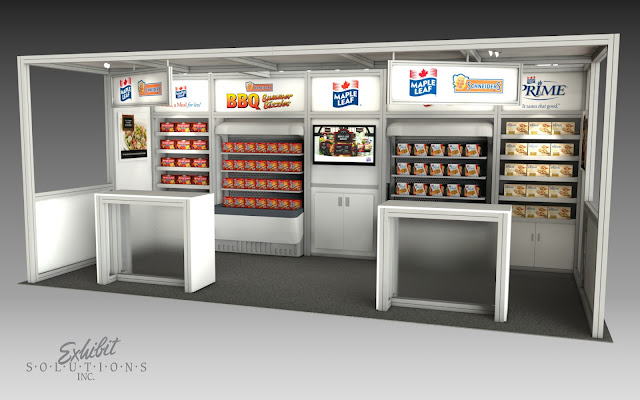We receive a lot of calls from exhibitors who want to make the jump from their draped table to a custom designed booth. Some already have bannerstands and pop-ups but are looking to make more of an impact and stand out from their competitors.
But how do you go from this...........................to this?
 |
| 10'x10' draped table |
 |
| 20'x20' custom exhibit |
Here are 5 quick tips to help you plan your move from your portable exhibit to a custom designed booth:
1. Do some research
Go online and do a bit of prep work. Look at exhibit houses in your area (or in the city you will be exhibiting), browse their gallery of work, check their capabilities to ensure that they specialize in custom designs, and make notes of design elements that you like - or don't like. Don't forget to ask colleagues or friends who have exhibited because they may have an exhibit house they could recommend. Choose two or three you would like to speak with and move on to step 2.
2. Make a wish list
I am a note taker and list maker - which brings us to my second suggestion: Write down all the features you or your team would like to have in your booth and don't forget to highlight the must-have elements. Some of the basic things your Account Manager will ask you about are:
- Booth size
- Seating
- Storage
- AV/Media
- Signage/Messaging
- Presentations or Demos
- Flooring
- Anything else?
Writing down all the elements you would like to see in your custom designed exhibit will help your account manager and booth designer understand what is important to you and your team.
3. Get your facts straight
This part is not as much fun as the design wish list but very important when you are making a sizeable investment in a custom designed exhibit. Think about and be prepared to answer questions on:
- SHOWS. When is your next show? How many times a year will you be using this exhibit? Where do you exhibit? Do you exhibit in different booth sizes at different shows?
- BUDGET. This is crucial because you are no longer looking at a $1000 to $2000 investment in your exhibit program - you might be looking at $30,000 for a 200sq ft booth [$144/$160 per sq ft based on the Exhibit Designers and Producers Association's 2011 Economic Survey - average cost for an in-line/single tier island exhibit].
- SERVICES. Who will manage all the show services (orders, shipping, set-up, dismantle....)? Will your team do this or do you want to work with a full-service exhibit house?
4. Ask questions
Once you have your exhibit house on the phone I know they will ask you for a lot of information. But don't forget that you are also trying to qualify them. Ask questions that will help you establish if you and your exhibit house are the right fit. Like buying a house - you want to trust your real estate agent, you want to feel like they understand what you are looking for, you want to build a relationship when making this kind of investment.
Ask the exhibit house about their custom design work, the cities they exhibit in, the services they provide, their production capabilities, the design process, visit their facilities and you can even ask them to speak to a couple of their existing clients for some feedback on their work.
5. Make the jump
If you have found the one (or two) exhibit houses that you have a good connection with, tell them that you would like to kick off the design process. This might involve an in-person meeting with the designer, a few concepts, and then a final design before you go into production - but your account manager should be walking you through each step of the design and build process.
Exhibitor magazine posts a lot of exhibitor success stories online (
Case Studies By Company). Even though they feature a lot of larger exhibits - you can read about exhibitor's innovative marketing plans, unique exhibits, and even find inspiration to make the leap to a custom designed exhibit.



.JPG)
.jpg)






.JPG)



.jpg)



